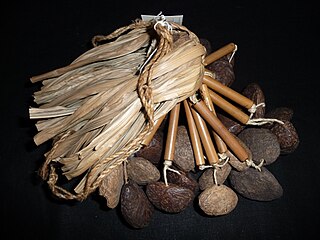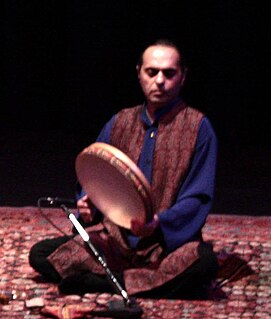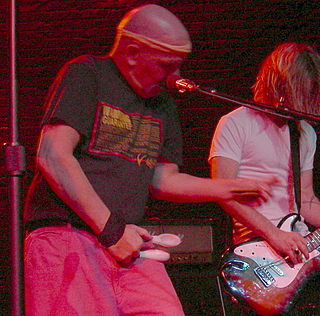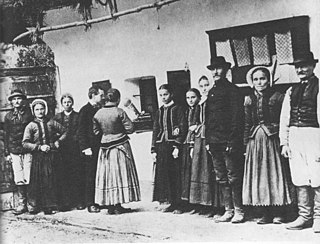
A percussion instrument is a musical instrument that is sounded by being struck or scraped by a beater ; struck, scraped or rubbed by hand; or struck against another similar instrument. The percussion family is believed to include the oldest musical instruments, following the human voice.

The tambourine is a musical instrument in the percussion family consisting of a frame, often of wood or plastic, with pairs of small metal jingles, called "zills". Classically the term tambourine denotes an instrument with a drumhead, though some variants may not have a head at all. Tambourines are often used with regular percussion sets. They can be mounted, for example on a stand as part of a drum kit, or they can be held in the hands and played by tapping or hitting the instrument.

The xylophone is a musical instrument in the percussion family that consists of wooden bars struck by mallets. Each bar is an idiophone tuned to a pitch of a musical scale, whether pentatonic or heptatonic in the case of many African and Asian instruments, diatonic in many western children's instruments, or chromatic for orchestral use.

The güiro is a Latin American percussion instrument consisting of an open-ended, hollow gourd with parallel notches cut in one side. It is played by rubbing a stick or tines along the notches to produce a ratchet sound.

The Jew's harp, also known as the jaw harp, mouth harp, Ozark harp or juice harp, is a lamellophone instrument, consisting of a flexible metal or bamboo tongue or reed attached to a frame. The tongue/reed is placed in the performer's mouth and plucked with the finger to produce a note. Each instrument produces one pitch only, with its multiples (overtones), though different sized instruments provide different pitches. There is no standard pitch.

The Mendoza, Mendozer, Monkey Stick, Murrumbidgee River Rattler, Lagerphone or Zob Stick is a traditional English percussion instrument, used in folk music. The origins of the name are not known but it is believed to stem from an association with Roma, Spanish and Italian buskers who were popular in London in the Victorian era. Alternatively, the name "Monkey Stick" could come from modern practice, in homage to the trained monkeys formerly used by buskers to solicit money from passersby. Some musicians have taken to fixing a small stuffed toy monkey to the tops of their instruments.

The term Chinese orchestra is most commonly used to refer to the modern Chinese orchestra that is found in China and various overseas Chinese communities. This modern Chinese orchestra first developed out of Jiangnan sizhu ensemble in the 1920s into a form that is based on the structure and principles of a Western symphony orchestra but using Chinese instruments. The orchestra is divided into four sections - wind, plucked strings, bow strings, and percussion, and usually performs modernized traditional music called guoyue. The orchestra may be referred to as Minzu Yuetuan or Minzu Yuedui in mainland China, Zhongyuetuan in Hong Kong, Huayuetuan in South East Asia, or Guoyuetuan in Taiwan, all meaning Chinese orchestra.

A rattle is a type of percussion instrument which produces a sound when shaken. Rattles are described in the Hornbostel–Sachs system as Shaken Idiophones or Rattles (112.1).

A dayereh is a medium-sized frame drum with jingles, used to accompany both popular and classical music in Bukharan Jews, Iran (Persia), Azerbaijan, the Caucasus, the Balkans, and many Central Asian countries such as Tajikistan, and Uzbekistan. Frame drums are also popular in many regions of Georgia, like Kartli, Kakheti, Tusheti, Samegrelo, Racha, and Imereti. This is a single headed percussion instrument which is not only found in Northern South Asia, Central Asia, and the Middle East, but also in parts of the Russian polar regions. The simple drum is formed by attaching a skin cover onto a wooden ring with glue and cloth ties. This is similar to the Persian daira and the Turkish def. Some daira have metal pieces attached to give them a tambourine-like quality.
Orchestral percussion are percussion instruments used in orchestras and concert bands mainly in classical music and related styles. The term can also refer to the department or study of performance on said instruments at a music school or conservatory. Generally within such a department, students are required to study all aspects of orchestral playing; with marimba, snare drum, and timpani being the three most basic areas of study. Orchestral percussion usually does not include drum set
This is an article on the terminology used to describe the music of Italy. There is also an article on Italian musical terms used in English.
Iranian musical instruments can be broadly classified into three categories: classical, Western and folk. Most of Persian musical instruments spread in the former Persian Empires states all over the Middle East, Caucasus, Central Asia and through adaptation, relations, and trade, in Europe and far regions of Asia. In ancient era, the Silk road had an effective role in this distribution.
Kshetram vadyam is the ritual music of South India. This is the main traditional music of Kerala state. It is a percussion dominated music.

Spoons can be played as a makeshift percussion instrument, or more specifically, an idiophone related to the castanets. They are played by hitting one spoon against the other.

A clapper is a basic form of percussion instrument. It consists of two long solid pieces that are clapped together producing sound. A straightforward instrument to produce and play, they exist in many forms in many different cultures around the world. Clappers can take a number of forms and be made of a wide variety of material. Wood is most common, but metal and ivory have also been used. The plastic thundersticks that have recently come to be popular at sporting events can be considered a form of inflated plastic clapper.

There are several overlapping schemes for the classification of percussion instruments.
















